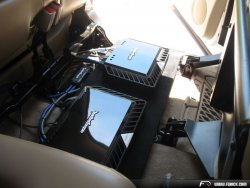If you have enough power to your amps, and your gains set properly, you should not be able to get your subs to clip.
Your sub will try to play the frequency sent to it regardless of whether the amp can keep up or not.
Having a 240 amp alt. and 1/0 supply should provide all the power your amps are looking for. If you are achieving a voltage drop of more than -2.5 (i.e. your voltage at idle is 14.0 and with the system cranked your are getting readings of less than 11.5)your system is requesting more power than your alt/battery set up can deliver and you need to upgrade.
Once installed, your setup should be fine. Most modern amps have small stiffening capacitors built in and you should have no more trouble, but once upgraded, if your voltages are stable and you still experience sub fade (when the subs seem like they are not hitting as hard or deep as a song with longer/lower bass lines progresses) you may want to try adding a stiffening capacitor just before the distribution block. With a long run (over 10ft), depending upon the cable and battery, sometimes the amps can request amperage at higher current rate than the cable can provide. (Think about a pipe that is 10 inches round, if you stick a garden hose in the other end, the water will always flow through and never back up, however, it will never flow rapidly, this is the case we want, 98% of the time, there is way more flow capacity than the amps will ever need)
but sometimes they request power so rapidly that even though we have a huge alt., battery and cable combination producing and supplying a ton of amperage, we just can't get it there fast enough, this is where a stiffening cap comes in. 12V batteries are designed to discharge very slowly and have a hard time responding to high amp draws quickly (think of the headlights dimming when the subs hit). A cap will not increase the capacity of the charging system, but will provide a small reservoir that can discharge quickly if the amps so request.
So to answer your question, yes, you should notice a change, you should be able to set your gains to match up your amps and head unit, enabling you to then crank the system without hearing any distortion, or have to worry about the damages causes by clipping.


